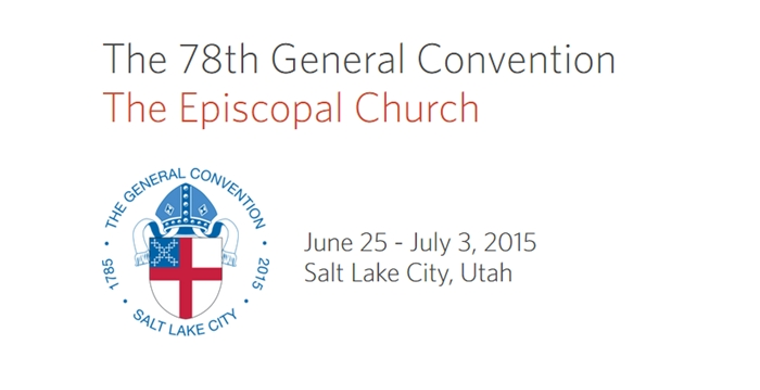SALT LAKE CITY, UT: Resolutions in the Face of a Shrinking Episcopal Church
By Michael Heidt in Salt Lake City
VOL Correspondent
www.virtueonline.org
June 23, 2015
The 78th General Convention of the Episcopal Church (TEC) is meeting in Salt Lake City against a backdrop of aging congregations and numeric decline. Several Resolutions reflect this downward trend, aiming to reimagine the structure and work of a shrinking Church.
According to TEC's most recent statistics, the Church's Average Sunday Attendance (ASA) has dropped significantly. In 2003, the year that Gene Robinson was consecrated as the world's first openly gay, partnered bishop, the Episcopal Church's ASA stood at 858,598 persons. 10 years later, in 2013, this figure had dropped to 657,102 persons, a decline of nearly 200,000 church goers.
During the same time frame, all 9 Provinces of the Episcopal Church reported a drop in Sunday attendance. Province 9, which is comprised of dioceses from South America, was especially hit, reporting a 22.6% decrease in attendance, with the Diocese of the Honduras shrinking by an alarming 43%. Congregations are also becoming smaller and older; 69% of churches reporting had an ASA of 100 or less, which is down 5% from 2009, and across the board, the average age of congregants is 61.
As dioceses and congregations have shrunk, the average age of clergy has risen to 58. 2013 statistics show that 33.2% of congregations have either part time or non-stipendiary clergy, and 12.3% are without clergy. This means that as of 2013, over 45% of TEC's 6,622 Parishes and Missions are unable to deploy a full time minister, and if they are, he or she will be fast approaching their senior years.
Several Resolutions before this year's General Convention attempt to address this new reality. For example, D038 proposes that the Church develop an "Index of Vitality," which would measure "signs of new and growing spiritual depth, even when other metrics may be static." The Resolution goes on to imply that institutional changes may be necessary, "Especially in the light of institutional changes that we make or that may be thrust upon us by changed and changing circumstances."
In an attempt to address these issues, the Task Force for Reimagining the Episcopal Church (TREC) is proposing a raft of Resolutions to reform the "Church's structures, governance, and administration." For example:
A001, Restructure for Spiritual Encounter, urges the Church's seminaries to train ordinands in "skill sets, and intellectual aptitude to engage the world and to transform and lead The Episcopal Church, looking beyond competency in the academic areas defined by canon." The Explanation of the Resolution states, "With the decline in membership and rising costs of maintaining staff and buildings, we may no longer be able to support the traditional model of one clergy, one parish. Many church buildings are unsustainable cost centers. To add to the problems, expensive seminary tuition leads to long-term debt for many clergy."
A002, Reimagine Dioceses, Bishops, and General Convention, recommends: "Frank discussion on the number and size of our dioceses and whether change is needed." The Resolution also suggests that diocesan giving to the National Church should become mandatory, except in the case of "pastoral exception." The Resolution also proposes streamlining General Convention into a unicameral, as opposed to bicameral, legislative body. A002's Explanation condemns the makeup of the House of Bishops, stating that "the current House of Bishops is one of the least diverse bodies in the whole Church--not only in demographics, but also in skills and life experience. Its makeup does not reflect the Church or society."
TREC is not alone in recommending structural change in the face of decline. Resolution D009 asks the Convention to revitalize existing congregations by creating a "revitalization network" that would consult with "clergy and lay leaders in order to help them re-vision their purpose, use of space, outreach to their communities, evangelism efforts, and new ways of proclaiming the gospel of Christ." The cost of this venture is listed at $700,000.
A100 addresses diocesan decline, resolving, "That the 78th General Convention encourages Bishops and Dioceses to prayerfully engage in a candid assessment of the viability and vitality of their Dioceses and to seek creative possibilities for enhancing the viability and vitality of their Dioceses."
Resolution C031 also focuses on dioceses, encouraging mergers of "contiguous dioceses." The Resolution's Explanation is telling and states, "In 1964 there were 7,992 congregations and 104 dioceses and mission area jurisdictions in the Episcopal Church. In 2013 there were 6,622 congregations and 111 dioceses and mission area jurisdictions (includes Navajoland). Over this 49 year period the number of congregations de-creased by 17.1% while the number of dioceses increased by 6.3%. We have too many dioceses serving a decreasing number of congregations."
The small size of Episcopal Church congregations is also recognized and, along with it, the inability of those who feel called to ministry to afford the cost of a seminary education. The Explanation of A045 states, "Many who feel called to serve small congregations, and many of those who are serving small congregations, cannot afford the cost, in terms of either time or financial resources, of full-time seminary formation." The Resolution asks for the creation of a "Task Force," costing $150,000, to find a solution to this problem.
The fate of these and similar Resolutions has yet to be decided on the floor of the Convention. Whether they will provide an antidote to a Church that has faced continuous decline for over a decade is unclear. That the philosophy which has driven the dwindling denomination for the last ten years remains in place, is less uncertain. Green politics, LGBT advocacy, and the secularist gospel of Inclusion are all alive and well in today's Episcopal Church; the same cannot be said for congregational and diocesan health.
The Rev. Michael Heidt is the editor of Forward in Christ magazine and a priest in the Diocese of Ft. Worth














